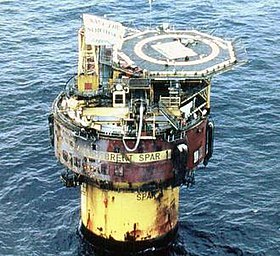It is almost unthinkable now that a petrochemical company would consider dumping a used oil platform at sea once it was surplus to requirements, but that is exactly what was angering activists in June 1995.
Oil giant Shell had announced plans to tow its no-longer-needed Brent Spar platform from its position in the North Sea to a site about 160 miles out from the west coast of Scotland. Once there it would be deliberately sunk in the deep Atlantic, left to rot on the seabed about 1.6 miles down.
 Brent Spar was not a drilling platform, but a floating oil storage facility moored about 1.2 miles from the ‘Brent A’ oil rig. Crude oil was pumped from the drilling rig to Brent Spar, which could hold up to 300,000 barrels. Oil tankers would then moor alongside Brent Spar to be filled up with the crude oil for transportation to refineries.
Brent Spar was not a drilling platform, but a floating oil storage facility moored about 1.2 miles from the ‘Brent A’ oil rig. Crude oil was pumped from the drilling rig to Brent Spar, which could hold up to 300,000 barrels. Oil tankers would then moor alongside Brent Spar to be filled up with the crude oil for transportation to refineries.
Built in 1976, Brent Spar was in service for almost 15 years, until a new pipeline connected the Brent oilfield directly to an oil terminal at Sullom Voe, in Shetland, rendering the floating storage facility redundant. It left the problem of what to do with it and by far the cheapest option was to tow it out into deep water and scuttle it.
That proposal angered environmentalists, with campaign group Greenpeace leading the opposition. It said that large amounts of crude oil and other toxic pollutants left inside Brent Spar would eventually leak out, causing significant ecological damage.
By June 1995, plans to scuttle Brent Spar in the Atlantic were well advanced, with tugs arriving and beginning the slow operation on the 11th. They were shadowed by a Greenpeace ship, the Altair, which attempted to disrupt the operation in several ways. One was to fly activists and journalists onto the platform using its helicopter landing pad. Once there they took samples of substances still on the platform and estimated the facility still contained 5,500 tonnes of crude oil.
Back on shore Greenpeace mounted an energetic media campaign against the proposed dumping of Brent Spar, including calling for a boycott of all Shell products, not just in the UK but across Europe. Several European governments made formal protests to the plans, but the British Government backed Shell. On June 19th Prime Minister John Major, speaking in the House of Commons, defended the oil company’s plan to dispose of the 14,500 tonne structure at sea.
Just hours before it was due to be scuttled, two Greenpeace activists remained on board Brent Spar and vowed to remain there “until the death”. Then, on June 20th – 23 years ago today – everything changed.
In a dramatic U-turn, Shell announced it would not sink Brent Spar as planned, but instead tow it back to the shore for systematic decommissioning, avoiding the risk of marine pollution. Its spokesman denied that Greenpeace had forced the turnaround, but conceded that growing international pressure and concern had made its previous plan “untenable”.
The official statement from the oil company said: “Shell UK has decided to abandon deep water disposal and seek from the UK authorities a licence for onshore disposal. Shell UK Ltd still believes that deep water disposal of the Brent Spar is the best practicable environmental option, which was supported by independent studies.”
It was estimated that onshore decommissioning would cost around £43M, compared to the £4.5M cost of dumping the structure on the seabed. However, the boycott of Shell products had spread wider and faster than anticipated, causing a significant impact on its profits and public image. Greenpeace hailed the news as victory in the “Battle of Brent Spar”, although it was later found that its estimates of the types and quantities of pollutants on board were greatly exaggerated.
Instead, Brent Spar was towed to Norway and moored in a fjord there. In July 1998 all the governments of the north east Atlantic region agreed to ban future dumping at sea of steel-built oil installations. Four months later, Shell began dismantling Brent Spar, which was broken into five sections and much of the scrap eventually recycled to build the foundations of a new ferry terminal.
If it had been sunk in the deep Atlantic, Brent Spar would probably have caused far less pollution than the countess shipwrecks that happen every year. But the public outcry over the plan and subsequent change in the law signalled a growing awareness of environmental concerns and instigated procedural changes among many of the world’s leading oil businesses.
